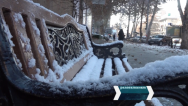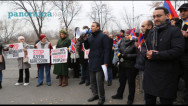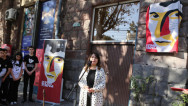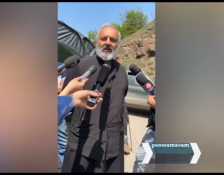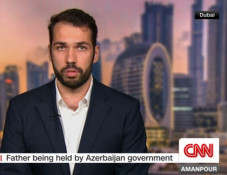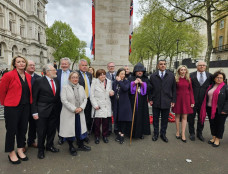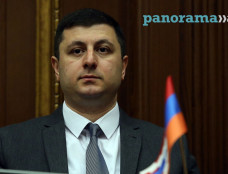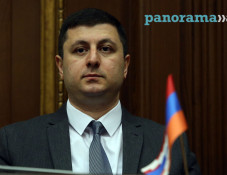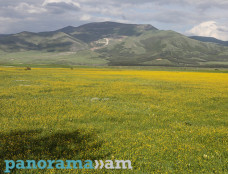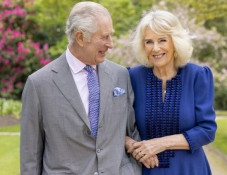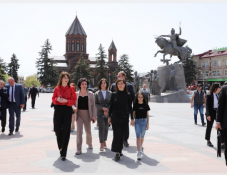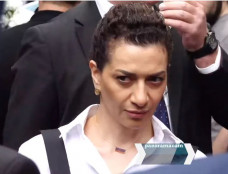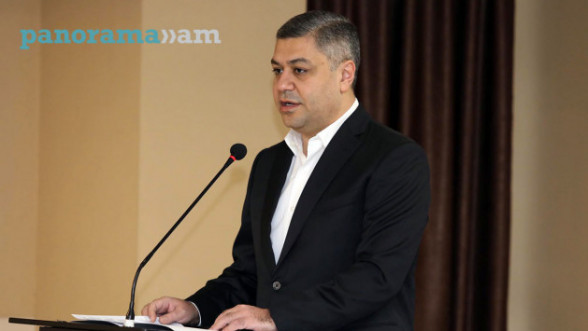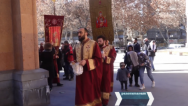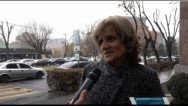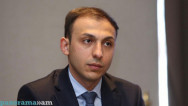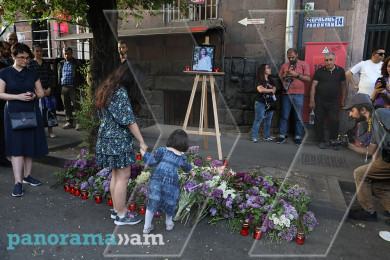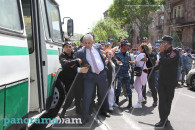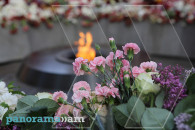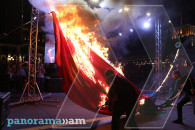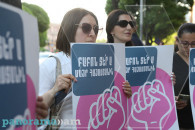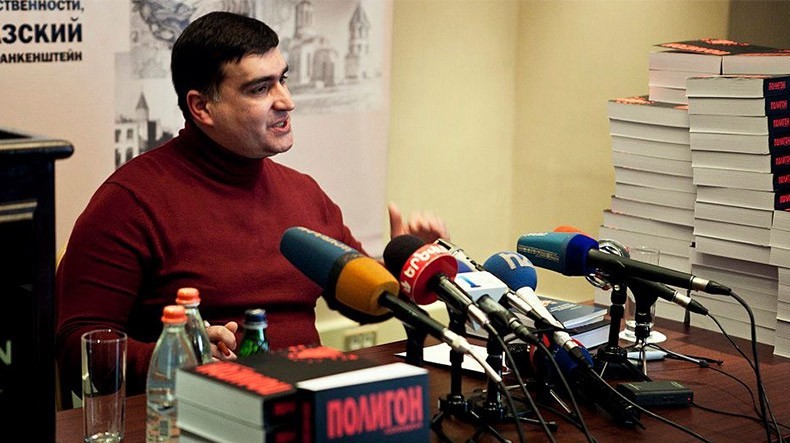
Aris Ghazinyan: Average seventh-century inhabitant of Yerevan embodied collective image of the Armenian of that time
In the first half of VII century Yerevan was not among the biggest Armenian cities, but owing to its border (frontier) position, it was the sharpest fixer of the changeable character of events, including the rivalry between Byzantine and Persia, the indicator of the power of these empires “at the moment.” Armenian journalist and researcher ArisGhazinyan writes about it in his book “Yerevan: with a cross or on the cross,” which is an attempt of setting and considering an extremely diverse range of processes directly or indirectly forming the character of the development of the territory in question and predetermining the inevitability of turning Yerevan into the main center of the Eastern Armenia, and later on into the capital of the recovered Armenian state.
The territory of Yerevan was that very “litmus place,” where the dynamics of changes of military-political and other concurrent processes found its reflection.
According to Ghazinyan, in VII century, the inhabitant of the border city Yerevan was a gardener, a craftsman, a merchant infinitely tired of constant wars. On the other hand, he almost put up with such state of affairs and somehow tried to adapt to these conditions.As a result, the border-frontier way of life separated two Armenian worlds, situated to the west and to the east from its older forge, but meanwhile also united and synthesized them. “In other words, an average inhabitant of Yerevan embodied the collective image of the Armenian of that conflicting time with the entire complex of doubts and preferences,” the author concludes, adding that it was really an extremely contradictory time, when the name “Armenian” itself began to be more frequently associated with the belonging of believers of the population to the Armenian Apostolic Church, as a result of which the assimilation (especially in Byzantine and Georgian lands) proceeded particularly intensively and gained enormous scales.
Then Ghazinyanmentions that Heraclius, the founder of the new Byzantine dynasty, started to consolidate the society under his power on the basis ofthe general belief of the followers of the Chalcedonian dogmatism and of the representatives of ancient eastern orthodox churches, who did not recognize the resolutions of the Council of Chalcedon. As an optimal variant, a monotheletismwas presented, which “professed that Jesus Christ has two natures but only one will.” After clearing several disputable questions, Armenian dignitaries and theologians expressed the opinion that “on the whole, the confession is acceptable,” but on the condition of excludingany references to the Council of Chalcedon, as well as any mentioning about it. A modified variant was already adopted in the local Council of Karin in 633. It was when the Armenian-Greek cryptographic inscription of CatholicosEzr appeared on the wall of Avan temple.
As a result, the special place of Yerevan in the Armenian history took shape. “Therefore, it is not surprising that in this very place (and only here) the only anti-patronal catholicosate in Armenia was placed, here the former head of this anti-patronal catholicosateHovnan was buried for twenty years, and, finally, here CatholicosEzr carved all his doubts and hesitations in epigraphs,” the author writes.
Ghazinyan informs that since VII century, an essentially new stage started in the chronicle of life of the Armenian nation, and in the world history in general. The formation of Islam as a religion and the subsequent establishment of the extensive Arab Caliphate marked the end of the traditional world.
At that time, Yerevan was a quite organized settlement, and it is proved by the fact that the attack of its citadel undertaken by the Arabs in 642 (or in 643) was a failure. “It is especially significant if we take into account the circumstance that by the time of the siege of Yerevan, the second pious caliph Umar could easily defeat the Byzantine army near Yarmouk, the Persians near Qadisiyyah, capture Jerusalem, and subdue Egypt,”the author notes.
Sebeos, a contemporary of the events,particularly mentions the battle of Yerevan. According to him, one of the three parts of the Israelite troops arrived in Atropatene and, conquering all the countries, took hostages and loot, gathered near Yerevan, fought against the fortress, but could not capture it.
“This information demonstrates the existence of fortifications in Yerevan, and which is especially important, a proper organization of internal life. It can be assumed that the defense of Yerevan to some extent contributed to the establishment of the relatively lenient regime in the Arabic part of the Ararat plain, and thanks to that, it was possible to hold two councils in Dvin under the leadership of CatholicosNerses III,”Ghazinyan informs.
“A very interesting piece of information” is presented in the book about the life of commander Surkhan, “who embodied the whole set of epoch-making contradictions”: he was an Arab military leader of Persian origin, who adopted Armenian Christianity. “The former soldier gained a huge popularity under the name David, which was given to him during baptism in the years of pastoral care of Anastas I Akoretsi (661-667) – the successor of Nerses III in the period when prince GrigorMamikonyan was (with the permission of the Caliphate) the commander-in-chief of the Armenian army,”Ghazinyan writes mentioning that the demonstrative transfer of the former Arab military leader to the bosom of the Church indicates the more or less loyal attitude of the Caliphate toward Armenia in the second half of VII century.
Serving in the Ararat plain,Surkhangot acquainted with the life of the Christians, fell in love with an Armenian girl, and decided to adopt the Christian faith. Surkhan (David) settled in the western part of Yerevan called Dzagavan built not far from the anti-patronal catholicate in Avan.
“This Christian settled down, got married, and brought up his children, and cultivated harvest not anywhere, but in Yerevan district. From the outside, all that was like a real medieval phantasmagoria, which the nations inhabiting the Caliphate refused to comprehend. Indeed, in that very time when the half of the world forcibly adopted Islam, a rite of baptism of a former Muslim,
an Arab commander, was carried out almost under the caliph’s nose, and at the highest level, with the participation of the heads of Armenian spiritual and military authorities,”Ghazinyan writes.
However, the “idyll” could not continue forever, and already in the very beginning of VIII century, a new battle between the Armenians and the Arabs took place near the walls of Yerevan, and it was hard to avoid due to a number of factors.
It was in those hard times when Yerevan was again mentioned in historical annals. “An Armenian manuscript called ‘The Life of David’ is among the preserved sources, and at the boundary of IX and X centuries, HovhannesDraskhanakertsi certainly used it for describing the events of the second half of VII century. This explains his reference to the story about the Arab military leader David, who adopted Christianity: ‘After a while, he adopted a martyr’s palm in Dvin. Then a battle was going on near qaghaqagyugh Yerevan; those, who described that war before us, give enough information about it’,”Ghazinyan informs.
Appearing in Draskhanakertsi’s story as a town-like settlement (qaghaqagyugh), Yerevan could not resist in the battle –Muhammad ibn Marwan and Abdullah managed to capture the fortress and Christian David. “His demonstrative baptism, in its time marked with the ‘total connivance’ of the highly respected caliph, was remembered several decades later as the gravest act ever committed by a devout Muslim in the territory of Armenia.Significantly,along with the strategic mission of capturing Yerevan, the Arabs also tried to achieve a public trial against the deserted military leader as an admonition to those, who still doubted,”Ghazinyan writes.
As the author informs, in the beginning of VIII century, the Armenian nation desperately resisted Saracens not only in Yerevan: there were battles on Sevan island, on the bank of Aras river near Vardanakert, around Drachpet, and all this threatened to develop into a nationwide rebellion leaded by the Armenian elite.
“In these circumstances, the Ishmaelites took a step, which later began to be associated with such notions as Muslim insidiousness and Armenian naivety in the consciousness of the Christian population of Armenia. In 705, under the pretext of negotiating and signing a truce, the Arabs invited several hundred princes to Nakhijevan and to the neighboring village Khram, and burned them alive in the local churches. Therefore, the revolted nation was practically beheaded, and Saracen amusement started,”Ghazinyan writes noting that aneven severer regime of persecutions was established in the country: taxes grew twice, and even a fee for obligatory lead stamp was charged.
“In that period, Yerevan was not in the condition to persevere in the whirl of intense political-demographic processes. However, on this very background, its main peculiarity is highlighted: the city revealed its ability to stand against challenges. Being a center of historical contradictions, it seemed to filter them, pass them through its porous volcanic surface, on which only the most vital could settle. In this context, no other Armenian city reflects the philosophy of the national history – ‘the vegetative ability’ of an eternally reviving nation to the extent that the modern Armenian capital does,”Ghazinyan writes.
However, after several millennia, Yerevan showed that it survived. It was not abandoned either in the period of the tough Arab oppressions oreven after three catastrophic earthquakes with the epicenter in the Ararat plain in IX century: the author writes that no less than eight generations of Yerevan were able to preserve their national identity and show a rarest indicator of ethno-cultural immunity in conditions of the most severe religious repressions inhabiting the native area.
At the boundary of IX and X centuries, as a result of the weakening of the Caliphate, the Armenian dynasty Bagratuni (Bagratid) declared the independence of its kingdom and announced its right to a sovereign throne in Kars. A bit earlier (in the middle of IX century), a new Catholicos, Zacharias Dzagetsi, was elected in the outskirt of Yerevan.
The election of the Supreme hierarch of the church in Yerevan district is an evidence of the increased importance of the place, especially given that the event took place several years before the official declaration of the Armenian kingdom, in a period, when the country was still under the Arab domination. Elected in the Yerevan suburb, the Catholicos became the first spiritual leader of the kingdom, which recovered its independence.
In that period, Yerevan was already mentioned more often on different occasions and in different regions. For example, an epigraphic inscription is known on the wall of the Sevan’s St. Arakelotschurch dating back to 874, which informs that Ashot I donated the local monastery complex six villages, as well as gardens in Garni and Yerevan. Therefore, the stern restorer of the Armenian monarchy already viewed the area of Yerevan “under his jurisdiction.” Nevertheless, the author writes that some time was still required for conquering Yerevanback.
As a result of the famous battles on Sevan in the twenties of X century, the last manifestations of the Arab claims toward all Armenian lands ended. “Caliph Muqtadir had to officially recognize the independence of Armenia and put up with joining the Ararat plain with Dvin (the center of the abolished “Arminia” governorate) and Yerevan (under the walls of which the Arab army gave the first misfire) to the Bagratid Kingdom,”Ghazinyan informs.
Due to the favorable geographic position, the city gradually started to occupy a leading position among other settlements of Kotayk province. It was settled down on important inner communications, the roads from Dvin, Vagharshapat, Partaw, and Ani – the new capital of the state replacing the Kars throne in 961 – were unitedhere.
To be continued.
ArisGhazinyan’s “Yerevan: with a cross or on the cross” is a book about the social and political history of Yerevan and Yerevan district (as a habitat) since the declaration of Christianity to the beginning of XIX century. In addition to demonstrating historical facts based on archive documents and sources, the book also considers the fundamental theses of the Azerbaijani historiography and Pan-Turkic ideology aimed at appropriating the historical, cultural, and spiritual heritage of the Armenians and other nations of the region by falsifying their history.
Related news
- Aris Ghazinyan: Territory of Yerevan generates unlimited time in its limited borders
- Aris Ghazinyan: According to famous anthropologists, Armenians are descendants of ancient indigenous race, which preserved its type from any influence
- Aris Ghazinyan: According to orientalist Diakonoff's memories, most of Azerbaijani historians had “quite indirect relation” to science
- Aris Ghazinyan: Politicians and scientists in Turkey and Azerbaijan completely ignore primary sources on Yerevan history
- Aris Ghazinyan: Past and future in Azerbaijan are modeled upon decrees and program speeches of president
Newsfeed
Videos


